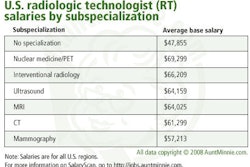After weeks of impasse, the U.S. Senate on July 9 passed a bill that postpones for 18 months a 10.6% pay cut to physicians for Medicare services. The legislation also includes provisions for the accreditation of imaging providers, a move that radiology advocates believe could help address the growing problem of imaging overutilization.
Lawmakers had been wrangling for weeks over the Medicare bill, which was intended in part to avert a pay cut mandated to take effect July 1 under the healthcare program's sustainable growth rate (SGR) formula. The House of Representatives had already passed the legislation, the Medicare Improvements for Patients and Providers Act of 2008 (H.R. 6331), but the Senate was unable to do so until yesterday.
The SGR dictates that once the volume of Medicare service reaches a particular threshold, payment for individual services is decreased to remain within a predetermined spending limit. But these limits impose an arbitrary payment level that doesn't reflect the cost to physicians of providing services, according to the American College of Radiology (ACR) of Reston, VA.
The Senate voted 69-30 in support of the bill. In a dramatic moment, Sen. Edward Kennedy (D-MA), who is fighting brain cancer, returned to the Senate floor to cast a decisive vote in favor.
The legislation also eliminates an additional 5% pay cut that had been scheduled to go into effect in January 2009. Rather than the 10.6% cut plus the 5% cut, the bill instead calls for a 0.5% payment increase for the year and a 1.1% increase for 2009.
"The ACR is gratified that Congress has acted to preserve access to care for our nation's seniors by averting this drastic reimbursement cut and at the same time increasing the quality of those services by enacting quality and safety standards for medical imaging providers," said Dr. James Thrall, chair of the ACR's Board of Chancellors.
Attacking overutilization?
Also part of the legislation is a mandate that providers of advanced diagnostic imaging services such as MR, CT, PET, and nuclear medicine be accredited by 2012 to be reimbursed by Medicare for the technical component of these exams. It also establishes a two-year voluntary demonstration program for appropriateness criteria for the use of medical imaging, following guidelines developed by the ACR and the American College of Cardiology (ACC) of Washington, DC.
These provisions help address concerns among lawmakers and regulators about growing imaging utilization, according to Andrew Whitman, vice president of the Arlington, VA-based Medical Imaging and Technology Alliance (MITA), a division of the National Electrical Manufacturers Association (NEMA).
"The accreditation mandate is a good way to ensure that the people who perform medical imaging tests are properly trained, that the image quality is of a certain level, and that the equipment is maintained and calibrated on a regular basis," Whitman said. "And the appropriateness criteria program is a clinically based utilization management tool that educates physicians about performing the right test, at the right time."
The bill states that prior authorization is not a good method for collecting appropriateness data, Whitman said, an important detail because private payors have been using this technique to try to clamp down on imaging overuse.
"We applaud Congress for putting forth a tool [in the appropriateness criteria program] that addresses imaging utilization by evaluating policy, rather than using blunt instruments like prior authorization or reimbursement cuts," Whitman said.
President Bush has threatened to veto the bill, stating that it cuts too deeply into Medicare's Advantage Plans, which allow millions of beneficiaries to choose to use Medicare HMOs, PPOs, private fee-for-service plans, and Special Needs Plans. Enough senators voted for the bill to override a veto, but if the president does use his veto power, the legislation will have to go back to both the House and the Senate for another round of voting.
For years, Congress has been passing stopgap legislation like H.R. 6331 to avoid physician payment cuts; the hope is that over the next 18 months, Congress and a new administration can develop a more permanent plan to fix the broken SGR formula. But lawmakers face a big challenge, according to Josh Cooper, senior director of government relations for the ACR.
"Every time Congress puts off these cuts, debt builds up," he said. "It's now at $220 billion. It will be quite a hurdle to figure out a better long-term physician payment policy."
By Kate Madden Yee
AuntMinnie.com staff writer
July 10, 2008
Related Reading
CMS delays Medicare payments due to SGR impasse, July 1, 2008
U.S. Senate blocks Medicare bill with HMO cuts, June 27, 2008
U.S. House moves to head off SGR cuts, June 25, 2008
Copyright © 2008 AuntMinnie.com




















